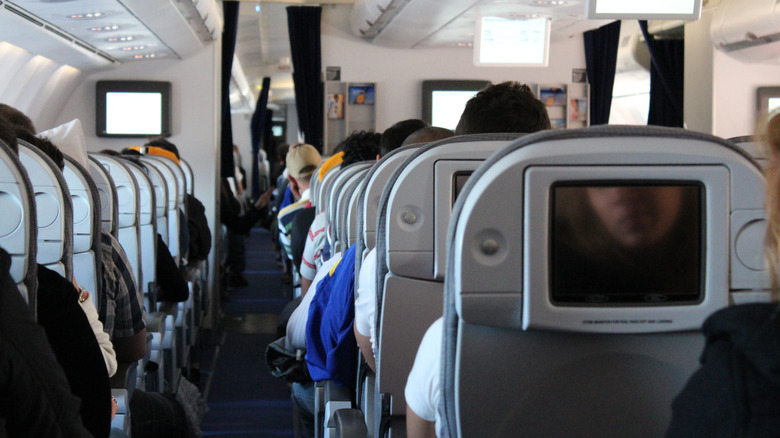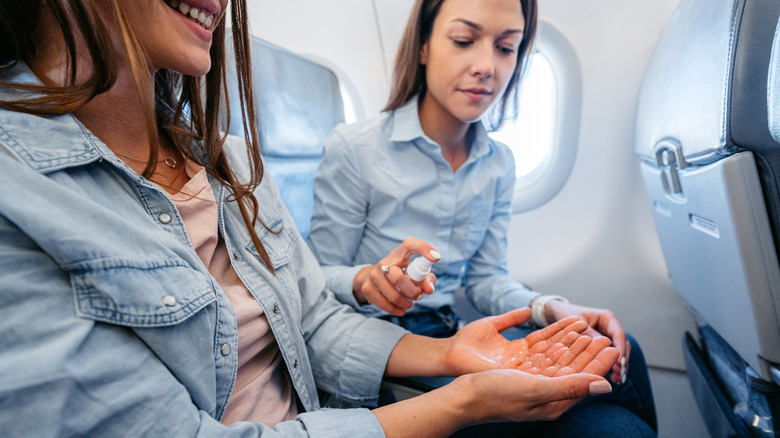A Disgusting Issue Tourists Think They'd Only Encounter At Hotels Might Be Even Worse On Airplanes
Traveling often comes with its fair share of hiccups, but some surprises are more unwelcome than others. Between climate shifts that spark colds and the occasional stomach upset from questionable water, you might think you've covered all the bases. But apparently, there's another pest to dodge on your adventures: Bedbugs. And these tiny stowaways aren't confined to the hotels or Airbnbs you meticulously inspect. In fact, they might be lurking in the airplanes taking you to your destination. Who knew?
As it turns out, bedbugs aren't even a rarity in commercial flights — they may even thrive in them. "[Bedbugs] are more common on planes than people like to admit," Reuven Noyman, owner of plane cleaning service NYC Steam Cleaning, told Fortune. "You get a lot of bedbugs and dust mites just because people are sitting on fabric. I mean realistically it's a haven for them." So much for the New York City Department of Health's claim that bedbugs are "rarely found" on public transport.
Turkish Airlines, for instance, had not one, not two, but three bedbug-related incidents in 2024 alone, with the airline admitting that these critters really do "occasionally" show up in public spaces like planes. But they went on to assure the public that any bug-infested aircraft gets a thorough inspection and treatment.
Still, the mental image of sharing your seat with bugs isn't exactly comforting. So, what's a traveler to do when these 6-legged hitchhikers could be anywhere? Don't worry — there are ways to protect yourself from these unwelcome travel companions. Because while bedbugs might love planes, that doesn't mean you have to bring them home.
How to avoid — and get rid of — pesky bedbugs
You might know how to dodge bedbugs in hotels — skipping the luggage rack, steering clear of the bed, the works — but what about on a plane? You can't exactly hover in mid-air or demand a seat change without getting branded as annoying by the crew. So, how do you outsmart these tiny stowaways when flying?
Start by treating your airplane seat like a potential crime scene. Check the seams for any suspicious specks (gross, but necessary), and consider covering the seat entirely. Travel seat covers exist, and they're worth the investment if bedbugs give you the heebie-jeebies. Keep your bags off the floor — that carpet is prime real estate for crawlers. Wearing light-colored clothes might also help spot any unwanted hitchhikers before they settle in. And consider bring your own pillow and blanket unless you trust the airline's to be 100% bug-free.
If you're flying with carry-on luggage, opt for a hard-shell suitcase instead of fabric, which bedbugs love to cling to. No hard-shell? Wrap your bag in a plastic case to make it less inviting. And if you suspect you've been exposed mid-flight, notify the crew right away. They might even take steps to kill the pests on the spot. Oh, and once you're home, resist the urge to unpack immediately.
Dr. Jason Singh, in a viral TikTok, suggested leaving your suitcase untouched for weeks. Why? "If your suitcase remains closed and undisturbed for at least two weeks, well, any bedbug egg or nymph present will likely die due to starvation or desiccation, so now you have a reason to be lazy, just like me," he said. So, now you've got a solid excuse to procrastinate on unpacking — it's not laziness; it's pest prevention. *wink*

